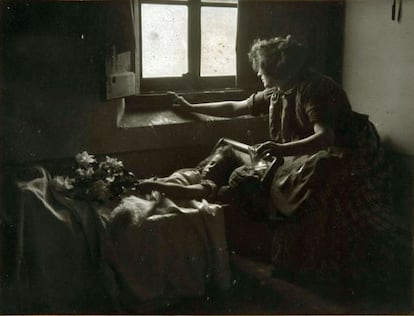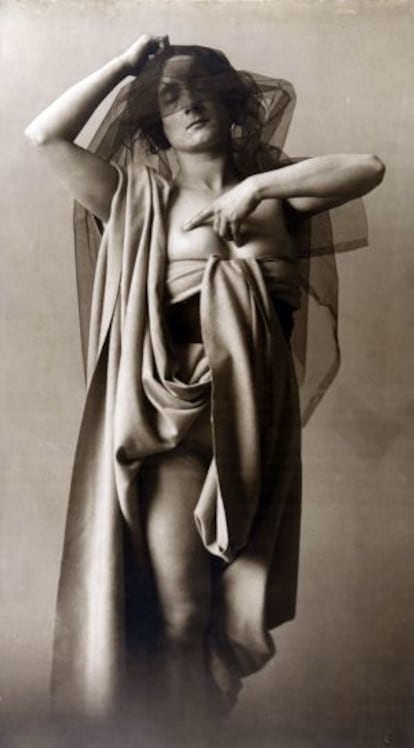Surprising developments
A rare peek at a pioneer photographer's large-scale works


In 1903 photographer Joan Vilatobà (1878-1954) won first prize in a contest organized by the magazine Ilustració Catalana. And he did so as much with his form as with his content. Vilatobà presented a series of enormous photographs measuring nearly a meter across that captivated almost everyone. He had made them using the unusual carbon print process, a laborious and complex technique that he had learnt in Germany barely a year before.

Vilatobà's fame was to skyrocket the following year when King Alfonso XIII bought one of his images and commissioned two more while visiting Catalonia. Alongside Miquel Renom, Pere Casas and José Ortiz Echagüe, he is considered one of the pioneers of Spanish pictorialist photography. But Vilatobà's theatrical, dreamlike images, his melancholy landscapes and his subjects - above all female nudes covered by veils - remain largely unknown. Now 48 of his images can be seen at the exhibition Joan Vilatobà, pionero del pictorialismo (Joan Vilatobà, pioneer of pictorialism) at the A34 gallery in Barcelona where some of his original works are also up for sale, priced between 2,500 and 15,000 euros.
Vilatobà was the first Catalan photographer to try to earn his living as an artist, rather than someone who took portraits at christenings, first communions and weddings. In 1919 he exhibited 63 of his works at the Círculo de Bellas Artes in Madrid, where the critics highlighted his meticulous and austere approach at a time when the fashion was for the ornamental. The following year he tried to mount his first solo show at the Galerias Layetanas in Barcelona and in his home town of Sabadell. "But Vilatobà had remained in the celebrated repertoire of his beginnings and had not departed from his melancholic and pictorialist style, which had little to do with the new esthetic of the first avant-gardists," explains the show's curator, Josep Casamartina.
In 1931 Vilatobà gave up photography, though he kept almost 2,000 plates, which were deposited in the Sabadell Historic Archive and the town's museum by his heirs. Forgotten for many years, his reputation underwent something of a revival in the 1970s, but his work has still been seen little. Now the sale of a large part of his work brings these huge and surprising images out into public view.
Joan Vilatobà, pionero del pictorialismo. Until November at A34, C/ Aribau 34, Barcelona. www.a34.es
Tu suscripción se está usando en otro dispositivo
¿Quieres añadir otro usuario a tu suscripción?
Si continúas leyendo en este dispositivo, no se podrá leer en el otro.
FlechaTu suscripción se está usando en otro dispositivo y solo puedes acceder a EL PAÍS desde un dispositivo a la vez.
Si quieres compartir tu cuenta, cambia tu suscripción a la modalidad Premium, así podrás añadir otro usuario. Cada uno accederá con su propia cuenta de email, lo que os permitirá personalizar vuestra experiencia en EL PAÍS.
¿Tienes una suscripción de empresa? Accede aquí para contratar más cuentas.
En el caso de no saber quién está usando tu cuenta, te recomendamos cambiar tu contraseña aquí.
Si decides continuar compartiendo tu cuenta, este mensaje se mostrará en tu dispositivo y en el de la otra persona que está usando tu cuenta de forma indefinida, afectando a tu experiencia de lectura. Puedes consultar aquí los términos y condiciones de la suscripción digital.
Últimas noticias
The complicated life of Francesca Albanese: A rising figure in Italy but barred from every bank by Trump’s sanctions
From digital curfews to blocking apps: How technology experts protect their children online
Why the price of coffee has skyrocketed: from Brazilian plantations to specialty coffee houses
Confined to a Cuban hospital: When electricity is a matter of life or death
Most viewed
- Pablo Escobar’s hippos: A serious environmental problem, 40 years on
- Why we lost the habit of sleeping in two segments and how that changed our sense of time
- Trump’s obsession with putting his name on everything is unprecedented in the United States
- The Florida Keys tourist paradise is besieged by immigration agents: ‘We’ve never seen anything like this’
- Charles Dubouloz, mountaineering star, retires at 36 with a farewell tour inspired by Walter Bonatti








































